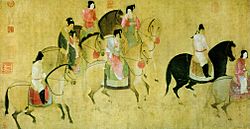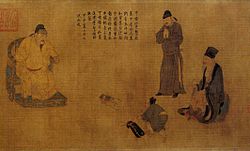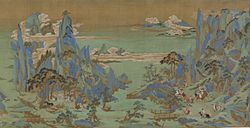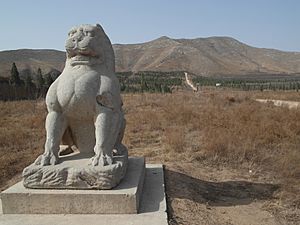Emperor Xuanzong of Tang facts for kids
Quick facts for kids Emperor Xuanzong of Tang唐玄宗 |
|||||||||||||||||||||
|---|---|---|---|---|---|---|---|---|---|---|---|---|---|---|---|---|---|---|---|---|---|
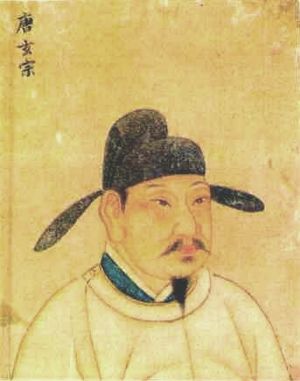 |
|||||||||||||||||||||
| Emperor of the Tang dynasty | |||||||||||||||||||||
| Reign | 8 September 712 – 12 August 756 | ||||||||||||||||||||
| Predecessor | Emperor Ruizong (Under Princess Taiping shadow) | ||||||||||||||||||||
| Successor | Emperor Suzong | ||||||||||||||||||||
| Born | 8 September 685 Luoyang |
||||||||||||||||||||
| Died | 3 May 762 (aged 76) Chang'an |
||||||||||||||||||||
| Consorts | Empress Wang (m. 693; died 725) Empress Zhenshun (died 737) Empress Yuanxian (m. 710; died 729) |
||||||||||||||||||||
| Issue | See § Family | ||||||||||||||||||||
|
|||||||||||||||||||||
| House | House of Li | ||||||||||||||||||||
| Father | Emperor Ruizong | ||||||||||||||||||||
| Mother | Empress Zhaocheng | ||||||||||||||||||||
| Signature |  |
||||||||||||||||||||
| Emperor Xuanzong of Tang | |||||||||||||||||||
|---|---|---|---|---|---|---|---|---|---|---|---|---|---|---|---|---|---|---|---|
"Xuanzong of Tang" in Chinese characters
|
|||||||||||||||||||
| Chinese | 唐玄宗 | ||||||||||||||||||
| Literal meaning | "Mystical Ancestor of the Tang" | ||||||||||||||||||
|
|||||||||||||||||||
| Tang Minghuang | |||||||||||||||||||
| Chinese | 唐明皇 | ||||||||||||||||||
| Literal meaning | "Bright Emperor of the Tang" | ||||||||||||||||||
|
|||||||||||||||||||
| Li Longji | |||||||||||||||||||
| Chinese | 李隆基 | ||||||||||||||||||
| Literal meaning | (personal name) | ||||||||||||||||||
|
|||||||||||||||||||
| Illustrious August | |||||||||||||||||||
| Chinese | 明皇帝 | ||||||||||||||||||
| Literal meaning | The bright ruler | ||||||||||||||||||
|
|||||||||||||||||||
| Li Sanlang | |||||||||||||||||||
| Chinese | 李三郎 | ||||||||||||||||||
| Literal meaning | The third young brother of Li family | ||||||||||||||||||
|
|||||||||||||||||||
Emperor Xuanzong of Tang, whose personal name was Li Longji, was the seventh emperor of the Tang dynasty in China. He ruled from 712 to 756 CE, making his reign of 44 years the longest in the Tang dynasty.
In the first half of his reign, Emperor Xuanzong was a hardworking and smart ruler. With help from skilled officials like Yao Chong and Song Jing, he led the Tang dynasty to a peak of culture and power. This time is often called a "golden age." However, later in his reign, Emperor Xuanzong became less focused on governing. He trusted certain people too much, like Li Linfu, Yang Guozhong, and An Lushan. This led to the end of the Tang golden age with the start of the An Lushan Rebellion.
Contents
Early Life and Family
Li Longji was born in Luoyang, the eastern capital of the Tang dynasty, in 685. His father was Emperor Ruizong, but at that time, his grandmother, Empress Dowager Wu, held the real power. Li Longji was the third son of Emperor Ruizong. His mother was Consort Dou, a high-ranking concubine.
As a child, Li Longji was said to be handsome and very talented in music. He had two older brothers and three younger brothers. He also had two younger sisters, Princess Jinxian and Princess Yuzhen, who later became Taoist nuns.
During Wu Zetian's Rule
In 690, Empress Dowager Wu took the throne herself, starting her own Zhou dynasty. She made her son, Li Longji's father, step down. In 692, Li Longji and his brothers were allowed to live outside the palace.
In 693, his mother, Consort Dou, and his father's wife, Crown Princess Liu, were killed by Wu Zetian inside the palace. After this, Li Longji's title was lowered to Prince of Linzi. He and his brothers were kept inside the palace and could not meet outsiders until 699.
Under Empress Wei's Influence
In 705, Wu Zetian was overthrown. Li Longji's uncle, Li Xian, became emperor again. Li Longji was given a position as a deputy minister. In 708, he became a secretary general in Lu Prefecture.
In 710, he was called back to the capital, Chang'an. He noticed that Emperor Zhongzong's powerful wife, Empress Wei, was controlling the government. Li Longji believed she would harm the Tang dynasty. So, he started building relationships with imperial guard commanders.
Taking the Throne
In the summer of 710, Emperor Zhongzong died suddenly. Many historians believe Empress Wei and her daughter poisoned him. They wanted Empress Wei to become empress like Wu Zetian. Emperor Zhongzong's young son, Li Chongmao, was made emperor, but Empress Wei held the real power.
Empress Wei's family and allies wanted her to become empress. They also planned to remove Li Longji's father, Li Dan, and his aunt, Princess Taiping. An official named Cui Riyong told Li Longji about this plan. Li Longji then secretly worked with Princess Taiping and other officials to act first. Imperial guard officers, who were unhappy with Empress Wei's nephews, also joined the plan.
The Coup Against Empress Wei
On July 21, 710, the group led by Li Longji began their attack. They first killed Empress Wei's nephews and cousin. Then, they attacked the palace. Empress Wei tried to escape but was killed by a guard. Many of her family members and allies were also killed. Li Longji displayed Empress Wei's body in the street.
After the coup, Princess Taiping and Li Longji urged Li Dan to take the throne from Li Chongmao. Li Dan became emperor again, known as Emperor Ruizong.
Becoming Crown Prince
Emperor Ruizong faced a challenge: who should be the crown prince? His oldest son, Li Chengqi, was the traditional choice. However, Li Longji had led the coup that brought his father back to power. Li Chengqi humbly asked to step aside for Li Longji. After some discussion, Emperor Ruizong agreed and made Li Longji the crown prince.
At first, Princess Taiping supported Li Longji as crown prince. She thought he was young and would be easy to control. However, she soon saw that Li Longji was strong-willed and did not like her influence. She became worried and tried to remove him from his position. She spread rumors and tried to find faults with him.
Struggle with Princess Taiping
Princess Taiping became very powerful. She had a lot of influence over Emperor Ruizong and many officials. She could decide who got promoted or demoted. Most important officials were her allies. She tried to get Li Longji removed as crown prince several times, but failed.
In 711, two chancellors, Song Jing and Yao Yuanzhi, suggested a plan to Emperor Ruizong. They wanted to send Li Longji's brothers and Princess Taiping away from the capital to reduce her influence. Emperor Ruizong agreed at first. But Princess Taiping found out and was very angry. She used her power to attack Song and Yao. Li Longji, fearing her anger, also asked for them to be punished. As a result, Song and Yao were demoted, and Princess Taiping returned to the capital.
Emperor Ruizong then ordered that Li Longji should decide all minor matters. This showed that Li Longji was his chosen successor. However, Emperor Ruizong still relied heavily on Princess Taiping for important decisions.
By late 711, Princess Taiping was even more powerful. She recommended many new chancellors. In 712, she had astrologers warn Emperor Ruizong that the imperial throne would change. She hoped Emperor Ruizong would suspect Li Longji of plotting. Instead, Emperor Ruizong offered to give the throne to Li Longji. Princess Taiping strongly opposed this, but Li Longji finally accepted. He became Emperor Xuanzong on September 8.
However, Emperor Ruizong remained as Taishang Huang (retired emperor) and kept much of the imperial power. His orders were still more important than Emperor Xuanzong's.
As Emperor
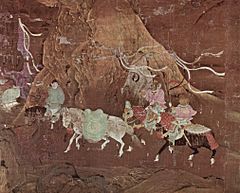
Emperor Xuanzong made his wife, Crown Princess Wang, empress. Princess Taiping continued to have great influence. Five of the seven chancellors at the time were her recommendations. The struggle between her and Emperor Xuanzong continued.
Ending Princess Taiping's Influence (712–713)
Some of Emperor Xuanzong's allies planned to kill several chancellors who supported Princess Taiping. But the plan was leaked. Emperor Ruizong ordered the arrest of Li Longji's allies. Emperor Xuanzong intervened, and they were exiled instead of executed.
By summer 713, Princess Taiping and her allies were planning to overthrow Emperor Xuanzong. They even discussed poisoning him. When Emperor Xuanzong learned of this, he decided to act first. On July 29, he sent soldiers to kill the main plotters. Many of Princess Taiping's allies were arrested and executed. Princess Taiping herself fled but was later ordered by Emperor Xuanzong to take her own life. Her sons and allies were also killed, and her vast wealth was taken by the government.
After this, Emperor Ruizong officially transferred all power to Emperor Xuanzong. Emperor Ruizong moved to a secondary palace and remained there until his death in 716.
The Golden Age (713–741)
Emperor Xuanzong's Kaiyuan era (713–741) is seen as a golden age in Chinese history. It was a time of political stability, peace, and economic growth. There were also big advancements in education, literature, music, and art.
Early Kaiyuan Era
Emperor Xuanzong changed the system of having many chancellors. He reduced the number to two or three. Yao Chong and Lu Huaishen were key chancellors. Yao was a very skilled administrator, and the government became very efficient.
In 714, Emperor Xuanzong punished corrupt officials from Wu Zetian's reign. He also exiled some chancellors from Emperor Zhongzong's time.
The Tang dynasty had conflicts with the Khitan and Xi tribes. In 714, General Xue Ne suffered a big loss against them. However, he later successfully defended against a Tibetan Empire attack. To better defend the borders, Emperor Xuanzong created the office of jiedushi (military governor). These governors had centralized command over large border areas. This system was later used in other parts of the empire.
In 714, Emperor Xuanzong made his second son, Li Siqian, crown prince. His wife, Empress Wang, did not have any sons.
The relationship with the Göktürks changed often. After their leader Qapaghan Qaghan was killed in 716, the Göktürks became less of a threat to China. Tang, the Tibetan Empire, and the Umayyad Caliphate also competed for influence in the Xiyu (Central Asia). Tang forces often fought to restore friendly kings in the region.
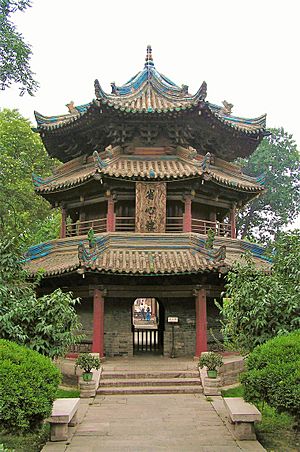
In 716, there was a large locust problem in central China. At Yao Chong's suggestion, Emperor Xuanzong ordered a huge effort to kill the locusts. This helped prevent a major famine. Later, Yao Chong resigned due to a corruption scandal involving his sons. Song Jing and Su Ting replaced him. Song Jing focused on honesty and law, which helped establish the good rule of the Kaiyuan era.
In 722, Empress Wang began to lose favor with Emperor Xuanzong. He considered replacing her with Consort Wu. An official who leaked this discussion was punished. Empress Wang was later removed from her position in 724. She died that same year. Emperor Xuanzong later regretted how he treated her. Consort Wu became the most important woman in the palace. However, Emperor Xuanzong never made her empress because officials worried about her powerful family and the safety of the crown prince.
In 725, Emperor Xuanzong held a grand ceremony at Mount Tai to honor heaven and earth.
Middle Kaiyuan Era
In 727, Tang forces under General Wang Junchuo attacked the Tibetan Empire. Wang Junchuo's father was captured by the Tibetans, which caused problems for Tang.
Around this time, Emperor Xuanzong built a special residential complex for imperial family members called the Mansion of the Ten Princes. From then on, imperial princes usually lived inside the palace.
In 729, Emperor Xuanzong began to focus on collecting more taxes to fill the imperial treasury. Some historians believe this was the start of financial burdens on the people.
In 730, the Khitan general Ketugan took control of the Khitan and Xi tribes. Tang sent an army to attack the Khitan. In 732, Tang forces dealt a serious defeat to Ketugan.
Late Kaiyuan Era
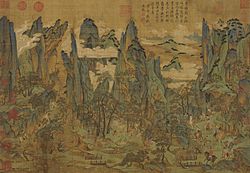
Tang also had conflicts with Balhae. In 733, Emperor Xuanzong tried to attack Balhae with forces from Silla, but it was not successful.
In 734, Li Linfu, a close ally of Consort Wu, became a chancellor. By 736, Emperor Xuanzong was described as being tired of important state affairs and starting to live a more lavish lifestyle. Zhang Jiuling, a chancellor known for his honesty, tried to advise the emperor, but he lost favor. Li Linfu gained power because of his connection to Consort Wu.
Li Linfu and Consort Wu wanted her son, Li Mao, to become crown prince instead of Li Ying. In 736, Li Linfu used tricks to make Emperor Xuanzong believe that Zhang Jiuling and another chancellor were causing problems. Zhang Jiuling was removed from office. Li Linfu then dominated the government for many years. He stopped officials from criticizing the emperor, which many historians see as the turning point for the Tang dynasty's decline.
In 737, Li Ying was removed as crown prince. Consort Wu died later that year. Emperor Xuanzong did not immediately make Li Mao crown prince. Instead, in 738, he chose an older son, Li Yu, to be the crown prince.
The Tianbao Era (742–756)
During the Tianbao era, Emperor Xuanzong became more interested in pleasure. He paid less attention to running the empire. Much of his power fell into the hands of corrupt officials like Li Linfu, and later, Yang Guozhong (a cousin of his favorite concubine, Yang Guifei).
In 751, Tang forces suffered a major defeat at the Battle of Talas against the Abbasid Caliphate. This temporarily reduced Tang's influence in Central Asia.
Meanwhile, the jiedushi (military governors), many of whom were not Han Chinese, gained more and more power in their regions. Generals like Geshu Han, Gao Xianzhi, and An Lushan became very successful. However, in 755, An Lushan started a huge rebellion known as the Anshi Rebellion. The rebels quickly captured the eastern capital, Luoyang, and then the main capital, Chang'an. Emperor Xuanzong fled to Sichuan during the war and gave up his throne to his son, Li Yu (who became Emperor Suzong).
Military Power and Favorites

Li Linfu encouraged Emperor Xuanzong to promote non-Han generals to lead large border armies. He believed these generals would be more loyal to the emperor. By 742, most of Tang's main forces were concentrated on the borders under these military governors.
In 744, the Eastern Tujue empire collapsed. The Huige tribe rose and became the main power in the region, formally submitting to Tang.
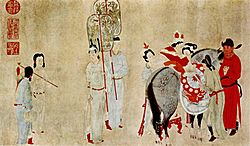
After Consort Wu's death, Emperor Xuanzong was sad. He became infatuated with his son Li Mao's wife, Yang Yuhuan. He made her a Taoist nun and secretly brought her into the palace. She became his favorite concubine, known as Yang Guifei. She and her family became very powerful and wealthy.
Li Linfu continued to hold power. But by 750, Yang Guozhong and other officials began to work against Li Linfu's allies.
The An Lushan Rebellion
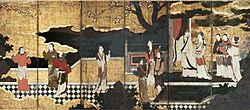
In 751, Tang faced defeats on two fronts. The Nanzhao kingdom rebelled and defeated Tang forces, causing many casualties. In the west, Gao Xianzhi lost a major battle to the Abbasid forces at Talas.
In 752, Li Linfu died. Yang Guozhong succeeded him as chancellor. Yang Guozhong and An Lushan became rivals. Yang Guozhong repeatedly warned Emperor Xuanzong that An Lushan was planning a rebellion. Emperor Xuanzong ignored these warnings.
In 755, An Lushan rebelled. His forces quickly captured Luoyang and then Chang'an. Emperor Xuanzong fled the capital with his family and key officials. On July 15, the imperial guards, angry at Yang Guozhong, killed him. They then forced Emperor Xuanzong to order the death of Consort Yang.
Emperor Xuanzong continued his journey to Sichuan. His son, Li Heng, went to Lingwu and was declared emperor (Emperor Suzong) on August 12. Emperor Xuanzong, not knowing his son had taken the throne, issued an order giving his sons various responsibilities under Li Heng's command. He later sent his chancellors to serve Emperor Suzong.
As Retired Emperor
After becoming retired emperor, Emperor Xuanzong mostly let Emperor Suzong manage the war against An Lushan's rebels. In late 757, Emperor Suzong, with help from the Huige, recaptured Chang'an. Emperor Suzong asked Emperor Xuanzong to return to the capital. Emperor Xuanzong initially hesitated but eventually agreed.
On his way back to Chang'an, Emperor Xuanzong tried to find Consort Yang Yuhuan's body for reburial, but it had decomposed. He only found her fragrance bag. He kept it and visited it daily. On January 17, 758, he arrived in Chang'an. In a grand ceremony, he formally declined Emperor Suzong's offer to return the throne. He said, "I had been the Son of Heaven for 50 years, and I did not consider it a great honor. Now, I am truly honored to be the father to the Son of Heaven." He lived in Xingqing Palace.
Emperor Xuanzong mostly stayed out of policy decisions. However, he sometimes still influenced Emperor Suzong. For example, he insisted on the punishment of some officials who had surrendered to An Lushan.
Emperor Xuanzong enjoyed his time at Xingqing Palace, with his daughter and close attendants. However, a powerful eunuch named Li Fuguo, who served Emperor Suzong, became jealous. Li Fuguo convinced Emperor Suzong that Emperor Xuanzong's attendants were plotting to regain power. In 760, Li Fuguo forced Emperor Xuanzong to move back to the main palace. His close attendants were exiled.
After being forcibly moved, Emperor Xuanzong became depressed and ill. He died on May 3, 762.
Later historians criticized Emperor Xuanzong for his lavish lifestyle and for trusting officials like Li Linfu, Yang Guozhong, and An Lushan. The great power he gave to military governors eventually led to more conflict and instability, which contributed to the decline of the Tang dynasty.
Poetry
Emperor Xuanzong had one poem included in the famous poetry collection Three Hundred Tang Poems. The poem is about the philosopher Confucius and his home state of Lu. It expresses sadness for things that are in the past, showing how temporary life is.
Key Officials During His Reign
- Cen Xi (712–713)
- Liu Youqiu (712, 713)
- Cui Shi (712–713)
- Lu Xiangxian (712–713)
- Wei Zhigu (712–713)
- Dou Huaizhen (712–713)
- Xiao Zhizhong (713)
- Guo Yuanzhen (713)
- Zhang Yue (713, 721–726)
- Yao Chong (713–716)
- Lu Huaishen (713–716)
- Xue Na (713)
- Yuan Qianyao (716, 720–729)
- Song Jing (716–720)
- Su Ting (716–720)
- Zhang Jiazhen (720–723)
- Wang Jun (723)
- Li Yuanhong (726–729)
- Du Xian (726–729)
- Xiao Song (728–733)
- Pei Guangting (729–733)
- Yuwen Rong (729)
- Han Xiu (733)
- Pei Yaoqing (733–736)
- Zhang Jiuling (733–736)
- Li Linfu (734–752)
- Niu Xianke (736–742)
- Li Shizhi (742–746)
- Chen Xilie (746–754)
- Yang Guozhong (752–756)
- Wei Jiansu (754–756)
- Cui Yuan (756)
- Fang Guan (756)
Images for kids
See also
 In Spanish: Emperador Xuanzong de Tang para niños
In Spanish: Emperador Xuanzong de Tang para niños


